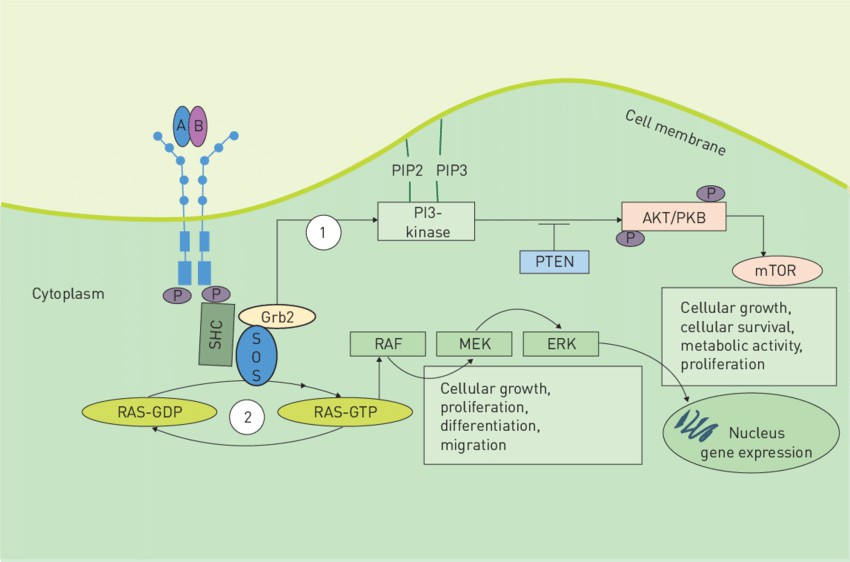Platelet-Derived Growth Factors (PDGFs)
About Platelet-Derived Growth Factors (PDGFs)
Platelet-derived growth factors (PDGFs) are dimeric glycoproteins produced by a variety of cell types (including endothelial cells, fibroblasts, vascular smooth muscle cells, osteoblasts, glial cells, and neurons), stored in the alpha granules of platelets, and released from platelets upon activation. PDGFs play an important role in angiogenesis, growth of blood vessels from pre-existing vascular tissues, mitogenesis (i.e., proliferation) of mesenchymal cells/ mesenchymal stem cells, mitogenesis (i.e., proliferation), and chemotaxis (i.e., directed migration) of mesenchymal cells.
The PDGFs family includes five isoforms: PDGF-A, PDGF-B, PDGF-C, PDGF-D, and PDGF-AB. These growth factors regulate biological activities such as cell proliferation, migration, differentiation, and matricellular proliferation by binding to PDGF receptors on the cell surface and activating downstream signaling pathways (as shown in Figure 1).
 Fig.1 Platelet-derived growth factor (PDGF) signaling pathway. (Kanaan R, et al., 2017)
Fig.1 Platelet-derived growth factor (PDGF) signaling pathway. (Kanaan R, et al., 2017)
Functions of Platelet-Derived Growth Factors (PDGFs)
Platelet-Derived Growth Factors (PDGFs) are a group of growth factors that play important roles in various cellular processes, particularly in the regulation of cell growth, proliferation, and tissue repair. Here are some key functions of PDGFs:
- Cell Growth and Proliferation
PDGFs promote the growth and proliferation of various cell types, including fibroblasts, smooth muscle cells, endothelial cells, and mesenchymal stem cells. They stimulate cell division, leading to increased cell numbers and tissue growth.
- Wound Healing and Tissue Repair
PDGFs play a critical role in wound healing and tissue repair processes. They are released by platelets and various cells in response to tissue injury. PDGFs stimulate the migration and proliferation of fibroblasts and endothelial cells, promoting the formation of granulation tissue and the synthesis of collagen and other extracellular matrix components. This accelerates the healing of wounds and contributes to tissue regeneration.
- Angiogenesis
PDGFs are involved in the regulation of angiogenesis, the formation of new blood vessels. They promote the migration and proliferation of endothelial cells, leading to the sprouting and branching of blood vessels. PDGFs also stimulate the recruitment of pericytes, which play a role in stabilizing and supporting newly formed blood vessels.
- Development and Differentiation
PDGFs participate in the development and differentiation of various tissues and organs during embryonic development. They contribute to the formation of the cardiovascular system, lung, kidney, and other organs. PDGFs influence cell fate decisions and the differentiation of mesenchymal cells into specific cell types.
- Mesenchymal Stem Cell Maintenance
PDGFs play a role in the maintenance and self-renewal of mesenchymal stem cells (MSCs). They promote the proliferation of MSCs and help maintain their multipotency, allowing them to differentiate into various cell types. PDGFs are crucial for tissue homeostasis and regeneration.
- Tumor Growth and Metastasis
Dysregulation of PDGF signaling has been implicated in cancer development and progression. PDGFs can stimulate cell proliferation, angiogenesis, and tissue remodeling in tumors. They contribute to tumor growth and support the formation of a tumor microenvironment that promotes cancer cell survival and metastasis.
- Bone Formation and Remodeling
PDGFs play a role in bone formation and remodeling processes. They stimulate the proliferation and differentiation of osteoblasts, the bone-forming cells. PDGFs also promote the recruitment of osteoclasts, which are involved in bone resorption and remodeling.
- Neural Development and Repair
PDGFs are involved in the development and repair of the nervous system. They influence the proliferation and migration of neural precursor cells during embryonic development. PDGFs also play a role in neuronal survival, myelination, and the regeneration of damaged neurons in the adult nervous system.
Overall, PDGFs are important regulators of cell growth, tissue repair, and development in various physiological and pathological contexts. Their functions extend to multiple cell types and organ systems, contributing to fundamental biological processes and holding potential implications for therapeutic interventions.
Reference:
- Kanaan R, Strange C. Use of multitarget tyrosine kinase inhibitors to attenuate platelet-derived growth factor signaling in lung disease[J].European Respiratory Review, 2017, 26(146).
- Piccin A, Pierro A M D, Canzian L, et al. Platelet gel: A new therapeutic tool with great potential[J]. Blood Transfusion, 2017, 15(4):1-8. DOI:10.2450/2016.0038-16.


